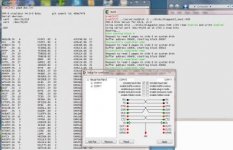jackrubin
Veteran Member
Kyle Owen's SerialDisk RK05 'emulator' can be run in stand-alone "virtual" mode, allowing you to load handlers, BUILD system disks, test server code, etc. without the need for any DEC hardware. This has been an on-again/off-again proposition because of a couple of bugs in SIMH that were exposed by Kyle's script but all issues have been resolved with the current (4a47113f) commit and this valuable tool now runs reliably in stand-alone mode. Prepare your disk image on your desk/laptop, transfer it to your server, then load and go on real hardware.
The requisite setup is already in the os8diskserver/SerialDisk/simh directory of Kyle's distribution. You will need to make sure that socat is loaded on your host system and that you have an Xclient on your remote system; for my Windows7 system, I use Xming. 'Make' a fresh instance of the current pdp8 sim, copy it into Kyle's simh directory, load your Xclient, and start the pdp8 program. Kyle's directory already has the appropriate disk.cfg and pdp8.ini files in place.
I've run SerialDisk in this mode using AbsoluteTelnet and PuTTY from my Windows system and from a Ubuntu terminal window in a VirtualBox session.
If SerialDisk seems to hang at "Booting...", you might need to give Xterm a little more time to get ready before sending the boot message to the server. I experienced this with PuTTY and got things to work by increasing the "sleep" interval before booting (line 18 in the pdp8.ini script) from 1 to 5. If you get funny socat errors (socket error 97) or the system hangs while executing the script, be sure you have the latest pdp8 build. If you get an xterm error about loading fonts (e.g. xterm: cannot load font '-misc-fixed-medium-r-semicondensed--13-120-75-75-c-60-iso10646-1'), make sure you have a .Xdefault file in your SerialDisk server home directory.
Thanks to Kyle for this great utility, Crawford Griffith for his help with the .ini script and Mark Pizzalto for super quick turnaround squashing SIMH bugs.
Jack
The requisite setup is already in the os8diskserver/SerialDisk/simh directory of Kyle's distribution. You will need to make sure that socat is loaded on your host system and that you have an Xclient on your remote system; for my Windows7 system, I use Xming. 'Make' a fresh instance of the current pdp8 sim, copy it into Kyle's simh directory, load your Xclient, and start the pdp8 program. Kyle's directory already has the appropriate disk.cfg and pdp8.ini files in place.
I've run SerialDisk in this mode using AbsoluteTelnet and PuTTY from my Windows system and from a Ubuntu terminal window in a VirtualBox session.
If SerialDisk seems to hang at "Booting...", you might need to give Xterm a little more time to get ready before sending the boot message to the server. I experienced this with PuTTY and got things to work by increasing the "sleep" interval before booting (line 18 in the pdp8.ini script) from 1 to 5. If you get funny socat errors (socket error 97) or the system hangs while executing the script, be sure you have the latest pdp8 build. If you get an xterm error about loading fonts (e.g. xterm: cannot load font '-misc-fixed-medium-r-semicondensed--13-120-75-75-c-60-iso10646-1'), make sure you have a .Xdefault file in your SerialDisk server home directory.
Thanks to Kyle for this great utility, Crawford Griffith for his help with the .ini script and Mark Pizzalto for super quick turnaround squashing SIMH bugs.
Jack
Last edited:

